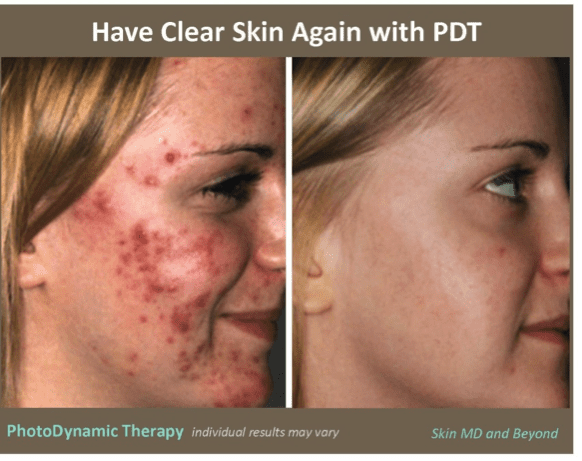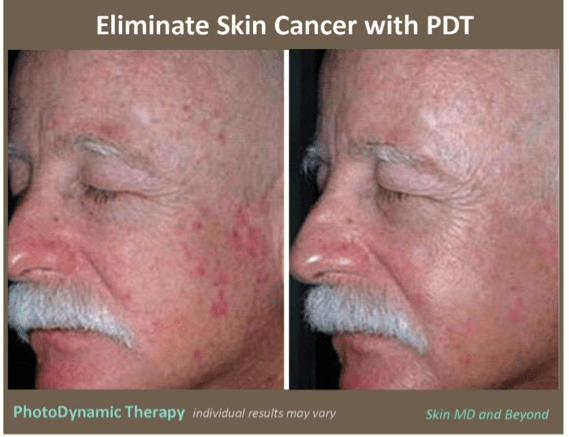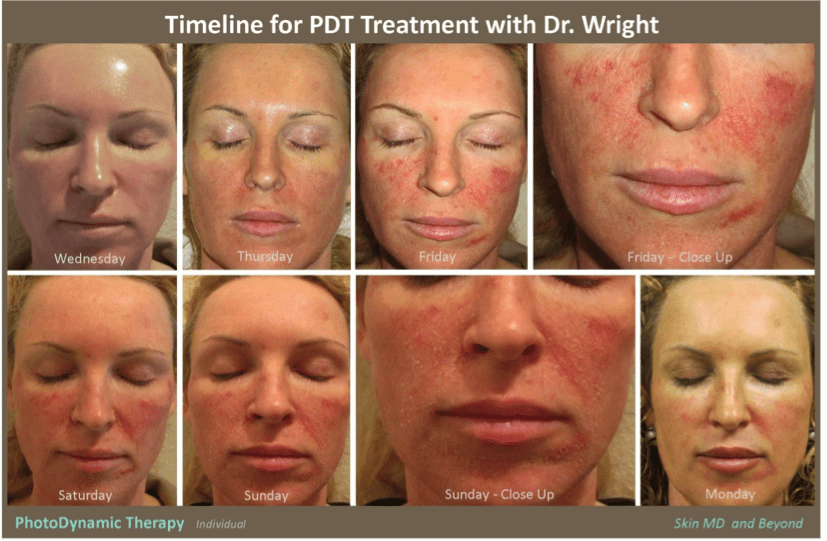(PDT) for Acne and Actinic Keratosis
Photodynamic Therapy (PDT) is a breakthrough dermatologic treatment which offers an especially effective in-office “power-level” treatment. PDT is highly successful in treating resistant, hard-to-treat, acne by combining light and a special light-activated solution (Levulan) that targets and destroys acne activity, reduces oil and minimizes pores. PDT also is used to remove sun damaged pre-cancerous zones and spots called Actinic Keratosis. Sun damage, fine lines, and blotchy pigmentation are also improved because of the positive effect of Levulan and the light treatment – making your aged rough skin younger and smoother.
Dr. Fiona Wright, a national leader in the field of non-surgical skin care treatments, was interviewed by NBC News Health Report to look at this novel treatment option- for these very damaging problems.
If you also would like to view Dr. Wright’s interview with NBC Heath News click here.
What is PhotoDynamic Therapy?
Photodynamic Acne Treatment (PDT) is a process by which a photosensitizing agent (Levulan) is applied to your skin. A photosensitizing agent is a special solution applied to the skin that is activated by a specific wavelength of light, which “turns it on.” Levulan has been used extensively for the treatment of a variety of different skin conditions. Levulan is a 20% solution of Aminolevulinic Acid (ALA). ALA is a “natural” product found in all humans throughout the body. It is a precursor for hemoglobin synthesis. You wouldn’t be able to make red blood cells to carry oxygen without ALA in your body.
The Levulan, which is a clear painless solution, is applied to your skin and left on for 15-60 minutes. It is then activated with a specific wavelength of light called BLU-U. This takes about 6-12 minutes. An alternate or combination treatment may also use PhotoFacial which drives the Levulan activation deeper into skin (Blu-U light 1-2 mm and PhotoFacial more than 5 mm).
The Levulan is absorbed by active cells like acne sebaceous glands, cancerous and damaged cells making the targeted cells more sensitive to the light. This combined interaction of the solution and the light is what gives rise to the term “photodynamic therapy”.
Prepping for PDT
- You must not be tan coming in for your treatment. Treating skin with a tan can produce white “striping” which can take several months to fade. Your skin MUST NOT BE TANNED.
- Stop the use of all Retin-A products and toners a week before your treatment.
- Patients who have a history of recurring cold sores (Herpes simplex type I) should start oral Valtrex 500 mg tablets, two tablets twice daily for three days – starting this prescription the day before your PDT treatment. The prescription for this product will be ordered for you.
- Make sure your skin is clean and free of all makeup, moisturizers, and sunscreens.
- Bring a hat, sunglasses, and scarf as you will need to cover your face from sunlight on your drive home.
The Procedure for Levulan Photodynamic Therapy(PDT)?
- Photography will be done by the staff before the Levulan is applied.
- You must sign a consent form.
- An acetone scrub and exfoliation procedure is performed. This will enhance the absorption of the Levulan and allow much more even uptake.
- Levulan is applied topically to the whole area – whole zone to be treated (such as the whole face, back of the hands, extensor part of the forearms). This is done by Dr. Wright on the initial treatment.
- During the Levulan application you may feel stinging, tingling, prickling, or burning of the lesions, but this should go away after a few minutes.
- You will be escorted to our Retreat with a beverage, to enjoy on our big screen The Scenes of Blue Planet and the Sounds of Nature, and to relax and unwind while the Levulan is left on for 45-60 minutes (incubation) before any light treatment.
- After the incubation period the Levulan will be activated with IPL (Intense Pulsed Light), Blu-U light or a combination of the two.
- You may be given an anesthetic topical cream applied prior to the light exposure.
- You will be given special goggles to wear to protect your eyes during the treatment.
- Post-treatment instructions will be given to you to care for your improved skin.
Post Care for PDT
- Stay indoors for 48 hours. Exposure to the sun within this time period can lead to a severe blistering burn in the areas that were treated.It is extremely important to keep the treated area out of the sun and bright lights for 48 hours. Sunscreen alone is NOT ENOUGH PROTECTION to prevent a burn in the first 48 hours after treatment.
- Use only the skincare products provided to wash and moisturize your skin. These will be provided at the end of your treatment.
- Plan for someone to drive you home and cover your face on the drive home with a hat with a brim, scarf for your face and large sunglasses.
- Avoid excessive heat exposure such as saunas, steam rooms, hot showers or baths, and strenuous exercising for 48 hours. This prevents the risk of blistering.
- After 48 hours and for the next 5-7 days, avoid harsh weather to the treated area. If outdoors, wear a hat with a brim and wear large sunglasses and use sunscreen.
- You should continue to use sunscreen daily for at least 4 weeks following treatment regardless of the time of year or if it is overcast or cloudy. Sun exposure may lead to the production of blotchy dark pigmentation which may take several months to fade.
- At the day of treatment you will be scheduled for a post-care facial. This is usually done 5-7 days after treatment. This allows us to assess your skin and help with the skin with any residual peeling.
What to Expect for the first week after Levulan PDT:
- There will be redness, and occasionally, mild blistering or bruising of the treated areas lasting from several hours to 3-14 days. This will depend on the sensitivity of your skin and the severity of your sun damage. Most people are completely healed within 7 days.
- After a normal treatment the skin will be swollen in the following 3-7 days
- There should be some discomfort, but no significant pain.
- The treated area will “crust”, “flake”, or look like a “cat scratch” to varying degrees depending on the sensitivity and dryness of your skin. Any areas that become crusted are pre-cancerous areas that have been successfully treated. Some crusting and scabbing is considered a good result. This should resolve within 3-14 days.
- Areas treated off of the face usually do not peel – but instead the skin will be rough in texture for 3-14days.
- Some patients have an exuberant response to PDT, and experience marked redness of their skin. Temporary swelling of the lips and around your eyes can occur for a few days. Darker pigmented patches called liver spots can become temporarily darker and then peel off leaving normal skin. (This usually occurs over seven to ten days.)
- Your skin will be more sensitive for a few days up to a couple of weeks after your treatment.
- After 1 week, there might be some residual redness that will subside after a few days and can be covered with make-up.
- You can return to normal activities immediately after treatment, as long as you avoid bright light and sunlight for 48 hours, as well as strenuous excercising.
- Avoid any aggressive skin care products such as scrubs, exfoliants, alpha or beta hydroxy acid products.
- Keep clothing from rubbing the treated area and avoid other irritation to the area.
- Do not get hairspray on the treated area.
- Notify the office should you have any prolonged redness, excessive puffiness, or other unusual side effects.
How much improvement can I expect?
Patients with severe sun damaged skin manifested by actinic keratosis, texture, and tone changes including mottled pigmentation and skin laxity may see excellent results. You may also see improvement of large pores and pitted acne scars. Active acne can improve dramatically.
How many treatments will it take to see the “Best Results”?
To achieve maximum improvement of pre-cancerous (actinic keratosis) sun damage, skin tone and texture, a series of three treatments 2-4 weeks apart is the most effective. Some patients with only actinic keratosis are happy with just one treatment. More treatments can be done at periodic intervals in the future to maintain the rejuvenated appearance of the skin.
Who should not have PDT (Levulan Photodynamic Therapy) treatments?
You should not be treated if you have:
- Skin sensitivity to blue light
- Porphyria (a disorder of the metabolism that can lead to sensitivity to light)
- Allergies to chemicals called porphyrins
- Darker skin tones have a higher risk of inflammatory hyperpigmentation and caution should be used.




